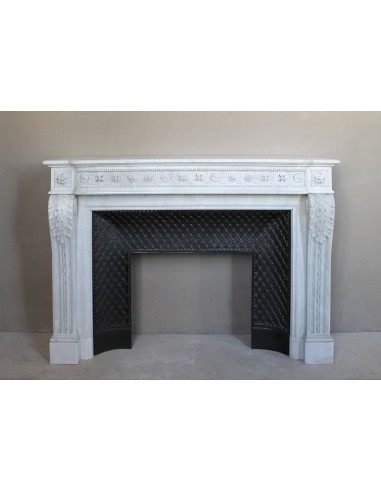In order for those who read us to understand in the best way possible the quality and beauty of this important sculpture, I will tell (briefly) the history of the Italian School of Sculpture, because it is there, in a very Italian workshop that our more than exceptional fireplace was born ...
Said “School ‘ (which then was the set of the many sculpture workshops that worked in the area then called Lunigiana (a name meaning ’Land of Luni,” a land located at the foot of the Apuan Alps), just to give you an idea of its age, was born 1400 years before the School considered the oldest in the world, the University of Bologna, which, born in the fateful “YEAR THOUSAND” (“Thousand no more Thousand,” remember?!)is “only” 1000 years old...
Coming back to us, the Lunense School was born in the year 399 B.C. (for from that year really began the work of this School, grappling with the Construction of Imperial Rome, probably the largest commission of sculptural work in the history of mankind) and ended around the 1940s.
For TWO THOUSAND FOUR HUNDRED YEARS, those who entered as apprentices in the workshops of Lunigiana became “MAESTRO” only after several lustrums of apprenticeship, depending on their skill and sensitivity. In the first 3,4 or 5 years the apprentice apprentice apprentice was not even paid. Most did not become masters and remained apprentices for life.
No one in the world could compete with the sculptors of Lunigiana, who, in addition to their manual skill, also invented and built effective and very fine hand tools (just think of the famous “violin”) whose discovery was religiously “secreted.” But, from the end of World War II onward, the world changes, Americanization will bring industrialization, and with it the abandonment of the countryside and heavier work, the massification of all labor, the replacement of manual labor by machine labor... A social and labor cataclysm that, in just a few decades, destroyed true craft work, including art sculpture.
The fireplace I am presenting to you IS CALLED MACARON, a name given to it by Parisians because the princely sculpture in the front (that series of little round flowers held together by a kind of stole that draws so many circles joined together), looks like a row of Macaron cookies, the most colorful, most sugary and most expensive cookies in the world, with which, those whose triglycerides are a little high, can easily and sweetly SUICIDE themselves.
Each of these cookies -- pardon? of these little flowers has a meaning: For example: The daisy is a tribute to Louis XIV, the Sun King; the violacea represents Absolute Fidelity (because its bulb blooms punctually every year) and Eternal Beauty (because of its endurance compared to most wildflowers that soon wither). Then there is a flower (unidentified, I have no green thumb..) which, twirling on itself represents the Comet Star. A curiosity that I have never noticed in other Macaron fireplace mantels: The presence, among all these little flowers, of a pair of oak leaves and berries, arboreal elements that are augurs of Strength, Nobility, Justice and Longevity..
To complete the frontal's sculptural load, let us look together at its “perlage” (in Italian it is called “coral work”), a series of pearls carved into the marble that reframes the frieze... The difference between this perlage and the vast majority of this kind of sculpture, lies in the fact that most of the time the “pearls” are joined together as if they were squashed to each other while in our case, between one pearl and another there is... the vision of a thread dividing one from the other. It is from these details that one can see the difference in quality between one work and another...
Even in the legs there is a total “covering” (from top to bottom) of various fine sculptural works..
Starting from the top: Beneath the sculpture of the two classic “Paris Roses,” the two capitals are covered with acanthus leaves, and already here we find a happy “oddity,” vertically and in the center of each of the two leaves, a very long (and also auspicious) ear of corn. I think I have seen at most two or three times in my life, on fireplaces, this decoration.
Where the acanthus leaves end it begins a ribbon that turns on itself until it reaches the fireplace plinth, this sculptural element , originated in the 1700s, is called the “Möbius ribbon ‘ and is the ’geometric” representation of infinity, which has inspired many artists. It evidently also inspired the Parisian architect who designed this unparalleled fireplace.
Are you getting bored? A moment of patience I'm almost done, I just have to highlight a detail of its cast iron insert: The whole surface of our (very refined) cast iron insert is decorated “a tapisserie” (in Italy we would say “tapestry”), all the intersections of its lines are highlighted by one of the flowers carved in the front, the Violacea.. Our cast iron insert could depict the Beauty of a large field of flowers....
PARISIAN DESIGN AND FINDING, ITALIAN SCULPTURE, INDUBITABLY LUNENSE (TUSCANY), PERFECT PRESERVATION.












































































